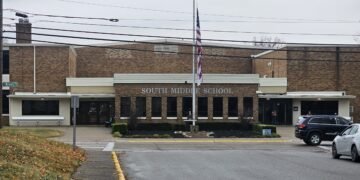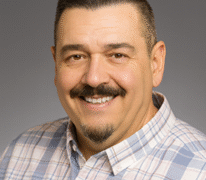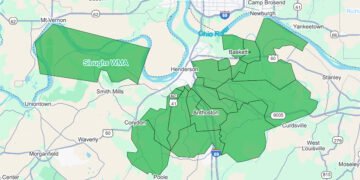Magistrates, judge say a restrictive wind ordinance or not even permitting windmills are possibilities
Members of Henderson County Fiscal Court say a recent study being conducted by the Federal Aviation Administration concerning a wind turbine proposal is a first step of the process and nothing has been decided about windmills coming to the county.
“It’s not a done deal,” said Judge-Executive Brad Schneider in response to those on social media who’ve concluded that a wind farm proposed by energy company Cordelio Power is a sure thing to locate in eastern Henderson County.
A recent statement by the company to this news site said that it is pursuing building 50-70 wind turbines in eastern Henderson County. The statement came on the heels of a study that the FAA is conducting regarding the windmills, which according to information submitted by Cordelio will measure 720 feet tall at the tip of the blade at full height.
Both magistrates Taylor Tompkins and Tim Southard say the process is in the very early stages. Both said that the FAA study is a first step and results of the study might find that the windmills aren’t allowed in the proposed locations, or at all.
Tompkins also said that there will be more approvals that Cordelio must get from other federal agencies and then the company would need to abide by local regulations that will be a part of the county’s wind energy ordinance. According to local officials interviewed for this article, official ordinance discussions haven’t yet begun, though Schneider said he’d like to have an ordinance in place by the end of the year.
The judge-executive said there will be many pieces to iron out, including height, proximity to houses and roads and location in fields. There’s also the possibility of “whether we want to permit them at all,” Schneider said.
And Southard and Magistrate Butch Puttman said an ordinance could be crafted with regulations so restrictive that wind energy companies may not want to build turbines here.
Perhaps the stickiest point that county elected officials will need to navigate is the debate concerning a person’s private property rights versus the community good.
Schneider said the ability of landowners to do with their property they feel is best is a “cornerstone of our democracy,” yet he agrees there are instances when a landowner’s actions are detrimental to the community, such as overgrown grass or using a yard to store junked cars that can attract pests and be a nuisance to neighbors.
Schneider said that he doesn’t believe simply the appearance of the massive windmills is enough to create a law that restricts them.
“Just because you don’t like the way something looks doesn’t abrogate the personal property rights of (your) neighbor,” he said.
The aesthetics of 720-foot wind turbines rising in the distance, however, is a concern—among others—for many residents voicing their complaints on social media. Similarly, two massive solar farms in Robards, that take up thousands of acres of cropland, have drawn complaints about their appearance.
Proponents of wind energy say a positive of the wind turbines, unlike thousands of solar panels, is that they each only take up one acre of cropland, so a farmer can continue to farm the land and at the same time receive a payout from the energy company.
As is the case with lease payments involving solar, the money is substantial—enough to ease the financial concerns of a family farm for a long time, Schneider said.
Tompkins and Southard say they will do their due diligence in preparation for drafting a wind energy ordinance. They plan to travel to communities north of Indianapolis where windmill farms are located to search out everyday people and ask them how the turbines affect their lives. Both said they do not want to talk to people that energy companies set them up with, but those that will give them their own take about the wind turbines in their communities.
“To get real feedback,” Tompkins said.
One topic they plan to ask about is the health concerns of windmills, specifically shadow flicker and noise pollution.
Flicker occurs when windmill blades pass in front of the sun’s ray and for a moment dim the area. According to several green energy websites, wind turbine companies track the direction of the sun’s light as it relates to the location of each windmill they site, attempting to find locations that cause the least amount of shadow flicker to residents living near wind turbines.
There are instances, though, in which shadow flicker could occur for specific residents during specific times of the year. For example, a resident may experience shadow flicker at his property from 8-8:30 a.m. for two weeks in April but not at any other time of the year, according to several sites.
Southard and Tompkins said they will pay for the trip, most likely occurring this summer, out of their own pockets.
Tompkins said he personally is not a proponent of wind turbines, but that he was elected to represent his constituents and keep his opinion out of it. He said he wants to do his due diligence to best represent his entire magisterial district.
A past article in the Hendersonian reported the massive scale of the solar installations in Robards. National Grid Renewables is developing a 1,500-acre Unbridled Solar Project and Next Era Energy is developing the 2,100-acre Sebree Solar project. Together, the two projects are the equivalent of 2,651 football fields, the article said.
Once work on those solar projects got going and residents saw the effects, their outcry pushed the fiscal court to put a 2-year moratorium on any further solar development, a time period in which Schneider said the court wanted to gather data and determine if the protections in the solar ordinance, such as vegetative screening, helped neighbors’ views. The moratorium was approved at a February fiscal court meeting.
Puttman said at the time the fiscal court was creating the solar ordinance he believed magistrates thoroughly vetted the possibilities. This time around he said the fiscal court may pursue an ordinance that “could very well be very restrictive.”
“We got to make sure we have an ordinance that dots the I’s and crosses the T’s,” he said. “We don’t want to make the same mistake twice with wind turbines.”
Tompkins urged concerned residents to contact him, other magistrates and Schneider to discuss this issue.
According to the elected officials, the governmental processes, including drafting an ordinance concerning wind turbines, are at their beginning stages.
“I will emphasize,” Schneider said. “It’s not a done deal.”

























